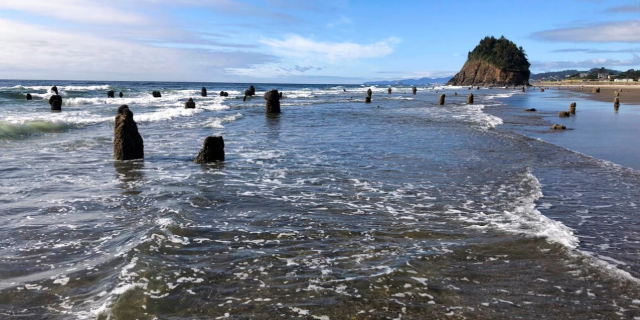Study: Major quake could reshape Oregon, flood entire coastal communities permanently
Published 9:47 am Saturday, May 3, 2025

- In this 2019 photo, evidence of a Cascadia earthquake's awesome destructive power is visible at the beach in Neskowin. A "ghost forest" of Sitka spruces juts up from the beach in the tiny town. The trees were likely buried by tsunami debris 2,000 years earlier, and partially uncovered by storms in 1997. AP Photo/Andrew Selsky
More than 115 square miles of Oregon coast could sink into the sea during a major event
Scientists have been sounding the alarm about a major earthquake off the Oregon coast for years, but a new study shows just how dramatically such a quake could reshape the state — including the permanent flooding of entire coastal communities.
Two of earth’s tectonic plates meet in the Cascadia Subduction Zone, a 600-mile fault along the Pacific Northwest coastline stretching from California to Canada. As one plate slides — or “subducts” — under the other, it creates pressure buildups that could become one of the strongest earthquakes on the planet, and could lead to a deadly tsunami.
Scientists have said for years that we’re due for another major earthquake. The last sizable earthquake in the Cascadia Subduction Zone occurred in 1700.
A new study, published Monday in the journal “Proceedings of the National Academy of Sciences” finds that more than 115 square miles of Oregon coast could sink into the sea during a major earthquake. According to the report, parts of the coastline could fall by more than six feet.
In addition to a tsunami, that earthquake will lead to chronic flooding, the report finds, threatening homes, farms and critical infrastructure up and down Oregon.
The study tries to predict how bad that flooding will be. If the earthquake were to happen today, the study finds, the floodplain — the area expected to experience flooding — could double or triple in size as a result of the earthquake and rising sea levels.
Major flooding will have a big impact on rescue efforts, scientists say. Many towns in the impact zone aren’t built to withstand a major quake or tsunami, and flooding at the scale the report indicates could take out up to five airports as well as more than two dozen schools, water treatment plants, hospitals, fire departments, police stations, and other critical facilities.
Whole towns, scientists say, may never be able to recover.
“The immediate effect of earthquake-driven subsidence will be a delay in response and recovery to the earthquake due to compromised assets,” the report read. “Long-term effects could render many coastal communities uninhabitable.”
The report calls on coastal communities and state and federal officials to rethink emergency planning along the coast.
“Preparing for these compound hazards can minimize long-term damage, ensure resilient communities, and protect critical coastal ecosystems from permanent degradation,: the report said.






